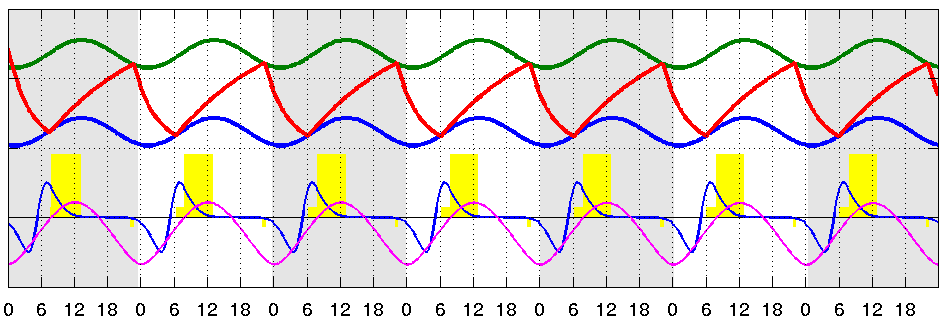An ongoing project that has already been the core of my Diploma thesis:
In Collaboration with the Neuroinformatic Research Group at the University of Applied Science in Schmalkalden, a mathematical model for human Sleep-Wake-Rhythm prediction is proposed, that accounts for both Sleep homoeostatis and adaption of the circadian day to daylight.
The model shown above is a combination of the 2 Process Model [Daan,Beersma,Borbely] and the Phase Response Curve [DeCoursey, Pittendrigh]. The 2 Process Model (2PM) consists of the upper and lower sinodial circadian thresholds for sleep onset (green) and waketime (blue), further called Process C. In between, the sleep pressure (S) raises during waketime and falls during sleep. If one of the thresholds of Process C is met, S changes from Sleep to Wake state or vice versa.
The Phase Response Curve (PRC, thin blue line) is a mathematical model that accounts for the adaptation of the inner circadian clock to the solar day. Based on various experiments it was verified, that bright light in the subjective morning would accelerate the circadian clock, and bright light in the subjective evening slows it. Habitual sleeptime at night prevents the circadian clock to be altered too much. In the proposed combined model, both Process C and PRC run at the same circadian period (23.5 to 25hrs). If light hits an active part of the PRC, the phase shift is applied instantly to Process C and accumulated to later shifting on PRC. Further, the total sum of absolute product of light and PRC value during the day is calculated for attenuation of both PRC and Process C.
Humans happen the have different Sleep-Wake behaviours (further called Chronotypes), ranging from "Larks" awaking before sunrise after only 4.5hrs of sleep to "Owls" awaking just before noon after perhaps 12hrs of sleep. Various model parameters must be fitted to account for people with different chronotypes, which was achieved using Genetic Algorithms. The illustration below shows the fitting of a simulated Sleep-Wake-Cycle with fitted model parameters to the Sleep-Wake-Cycle recorded in a sleep diary over almost 150 days.

